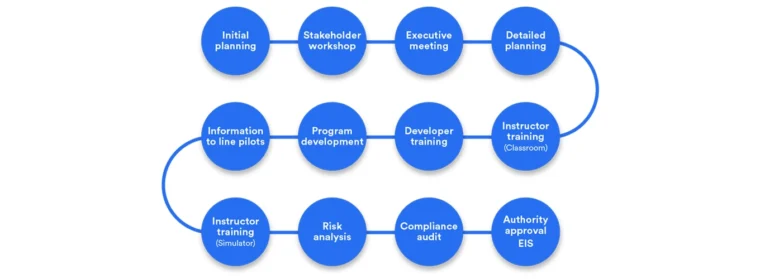Background
There have been several variations to the traditional training and checking program introduced by various regulatory authorities. The majority of these either reflect the FAA led AQP or European ATQP initiatives. Many operators are confused about the differences between these programs and EBT published by ICAO in 2013.
It is important to know that both AQP and ATQP were developed in response to concerns about the existing regulatory requirements. Both programs encourage operators to adopt more progressive training processes and offer relief from some existing regulatory requirements.
However, existing proficiency check requirements are largely unchanged, and the focus on the specification of discrete training or checking events remains. The following review simply highlights the history and characteristics of these two programs and compares them to EBT.
EBT represents a paradigm shift away from event-based training specification based on a competency-based approach.
Advanced Qualification Program
AQP is a voluntary, alternative method for qualifying and training crewmembers and operational personnel to traditional FAA requirements under 14 CFR Parts 121 and 135 for training and checking. The AQP concept was developed by an industry task force that met in 1987-88 and recommended measures to promote innovation, centralized oversight by a dedicated FAA Office, second in command training. Course approval was to be based on content and training aids rather than programmed hours and the incorporation of CRM.
AQP was originally introduced as an SFAR 58 in 1990 and now over 90% of US airline pilots train under the program. In many ways, AQP is a product of the rules and regulations that it seeks to update. AQP can only be understood if it is considered in terms of the traditional system it seeks to replace.
AQP employs a detailed Instructional Systems Design approach to allow flexibility to tailor training and incorporate CRM principles. The process is strongly data focused and aims to support safe operations through continuous improvement and evaluation. It also supports the train to proficiency concept that is underpinned by a detailed task analysis.
The ISD system employed by AQP seeks feedback from the continuing qualification or recurrent training program to make changes to the initial qualification curriculum. It seeks to be more flexible when introducing changes to both initial and recurrent training.
AQP also incorporates the notion of LOFT and LOE along with other specific training and evaluation-related sequences. One of these was the notion of “first look.” First look maneuvers are critical items that are evaluated without the crewmember practicing them first. This is designed to give a better appreciation of real line capability.
Voluntary participation in AQP allows for relief from some more onerous recurrent checking requirements but also specifies a very detailed approval and review process which includes instructor and evaluator training programs. This program emphasizes standardization in grading and assessment.
Alternative Training Qualification Program (ATQP)
ATQP is a European regulatory initiative that focusses on recurrent training and checking. Just like AQP it seeks to enhance safety by being more responsive to the operator’s specific requirements and areas of operations. It was included in European regulation in 2012.
ATQP is much clearer about extensions to qualification cycles than AQP and is not as rigidly focused on the ISD process as AQP. Instead, ATQP requires the development of a safety case that is supported by a variety of other requirements such as a task analysis and a data monitoring program.
Essentially, ATQP frees up time in the simulator program by extending required statutory tests, such as an engine failure on take-off, to twelve months during a License Proficiency Check (LPC) rather than every six months.
Similarly, the annual line check can be extended to once every 2 years. This is accomplished by allowing the requirements of the OPC to be more flexible and relate to data produced by the airlines’ own internal safety processes. While an LPC is still required for licensing purposes, the time normally devoted to the OPC can be used to conduct LOFT and LOE.
Evidence-based Training
EBT took a completely new approach to the conduct of training and assessment and, when fully implemented, is not hamstrung by the need to continue to comply with existing, legacy checking requirements.
EBT was able to leverage the very best features of AQP and ATQP as well as learn from operators that had been involved and experienced in these two programs. EBT embraced the notion of competency rather than event-based training.
Most check “events” that are embedded within traditional, AQP and ATQP systems still reflect those common failures that older technology aircraft suffered from in the 1970s and 1980s.
While regulatory requirements have been added to reflect the adoption of new technology and procedures such as ACAS or GPS and LVO, a complete review of the underlying, historical, or legacy requirements had not been accomplished.
EBT preserves the “first look” concept but this is conducted as a line-orientated flight and therefore a more relevant “first look” with assessments of underlying competencies. This assessment is used to tailor the learning to individual needs.
EBT Principles
The evidence
A comprehensive data report was compiled that reflected accident and incident data, actual flight and systems failure data, training reports, flight deck observations of “normal” operations, risk assessment and analysis, training criticality along with the input from manufacturers, regulators, industry and pilot associations, training experts and data analysts. This data report showed that there was some variation in the training need for differing generations of jet and propellor transport aircraft.
Real world focus
EBT recognizes that not all possible events can be specified, let alone practiced. Instead EBT is focused on developing sound underlying competencies that can be brought to bear in any situation. The crew is presented with unknown, often ambiguous, drawn from the real-world. They are interrupted and distracted and deal with the ongoing consequences of failures or issues and not just display initial actions. Remediation focusses on developing the weak competency rather than just repeating an event.
Learning from the positive
While a standard must still be reached, EBT also encourages positive performance and behaviors. Historically, safety, incident and accident data has focused on the negative aspects, while little information has been captured about positive crew performance that has saved the day. Traditional check and training have also focused on the negatives. Crews survive training sessions rather than learn and develop from them.
Focus on process
During traditional training sessions, crews do not consider options, nor do they make informed decisions based on risk. They rarely have the opportunity to review and change their mind if the plan is not working. Quite simply, the mix of events they face often drive the crew down a certain, expected path with little room from problem solving, option generation, risk-assessment or review. EBT is focused on giving crews choices within a range of real-world parameters so they can practice those skills that are important in the real-world.
Immersion
Crews deal with interruptions, inconsistencies, and incomplete information in the real-world. It is often break-downs in these management areas which trigger the pathway to a disastrous outcome rather than a catastrophic system failure. EBT aims to present crews with these same issues during training and develops strategies to deal with these real-world issues.
Summary
In summary, both AQP and ATQP encouraged operators to take a more real world and immersive (with LOE and LOFT) approach to training and checking.
However, traditional check requirements were largely maintained and there were no real mechanisms that promoted a stronger focus on process and underlying competency improvement as the systems were still essentially event-based in design.
EBT was unfettered by legacy regulatory requirements during its design. It is based upon a comprehensive data review that touched all aspects of airline operations, including a comprehensive accident and incident review. Rather than specify events, EBT consists of training topics tailored to a generation of aircraft design. These topics are used to support the design of scenarios. The operator can tailor the design to their own operational environment and imperatives.
EBT strives for excellence in process and underlying competencies. Events and data simply inform the exposure according to a risk and training criticality. EBT aims to create a learning environment where pilots can develop underlying competencies to manage any situation, rather than practice a series of events that may or may not actually happen.




